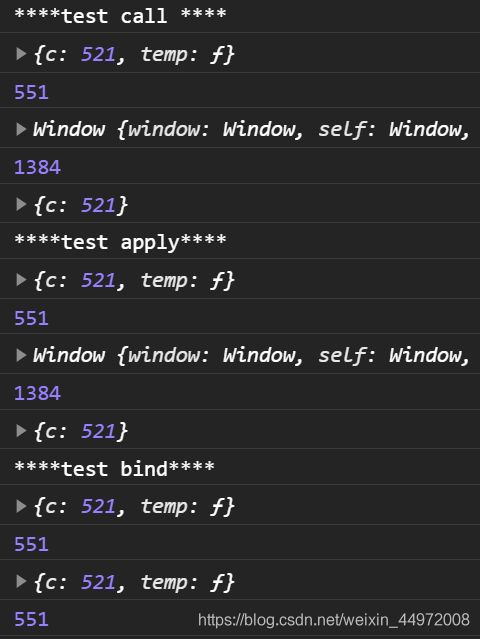【JS】函数定义与调用方式-函数this指向问题-call-apply-bind方法使用与自定义
文章目录
- 1. 函数定义的几种方式
-
- 1.1 函数声明式
- 1.2 函数表达式
- 1.3 构造函数式
- 1.4 箭头函数
- 1.5 注意点
- 2. 函数调用的几种方式
-
- 2.1 普通函数
- 2.2 对象的方法
- 2.3 构造函数
- 2.4 绑定事件函数
- 2.5 定时器函数
- 2.6 立即执行函数
- 3. 函数中this指向
- 4. 改变函数的this指向
-
- 4.1 使用call方法
-
- 应用
- 4.2 使用apply方法
-
- 应用
- 4.3 使用bind方法
-
- 应用
- 4.4 区别与联系
-
- 相同
- 区别
- 主要应用场景
- 5. 自定义call、apply、bind方法
-
- call.js
- apply.js
- call.js
- 测试
1. 函数定义的几种方式
1.1 函数声明式
function fn(a, b) {
return a + b;
}
1.2 函数表达式
let fun = function(a, b){
return a + b;
}
1.3 构造函数式
let fun = new Function('a', 'b', 'return a + b')
1.4 箭头函数
let fn = (a, b) => {
return a + b;
};
关于箭头函数的更多内容,请见【ES6】JavaScript函数-箭头函数-this指向-简写
1.5 注意点
所有函数都是 Function 的实例对象, 属于对象 instanceof Object

2. 函数调用的几种方式
2.1 普通函数
fun()
fun.call()
2.2 对象的方法
obj.fun()
2.3 构造函数
new Fun()
2.4 绑定事件函数
触发事件调用
btn.onclick = function(){
}; // 点击按钮调用
2.5 定时器函数
定时器到达指定时间自动调用
setInterval(function(){
}, 1000) // 定时器自动一秒钟调用一次
2.6 立即执行函数
自动自己调用
(function(){
})()
3. 函数中this指向
根据调用方式不同,this的指向也不同,一般指向调用者
具体总结表格如下所示
| 调用方式 | this指向 |
|---|---|
| 普通函数调用 | window |
| 构造函数调用 | 实例对象, 原型对象里面的方法也指向实例对象 |
| 对象方法调用 | 该方法所属对象 |
| 事件绑定方法 | 绑定事件对象 |
| 定时器函数 | window |
| 立即执行函数 | window |
- 注意
在箭头函数中,this是静态的,this始终指向函数声明时所在作用域下的this的值
关于箭头函数的更多内容,请见【ES6】JavaScript函数-箭头函数-this指向-简写
4. 改变函数的this指向
4.1 使用call方法
fun.call(thisArg, arg1, arg2, ...)
作用:1. 调用函数 2. 改变函数this指向
function add(a, b) {
console.log(a + b)
}
let obj = {
c: 520
}
add(1,2) // this指向window
add.call(obj, 1, 2) // this指向obj
应用
主要的作用是可以实现继承
function Father(uname, age, sex) {
this.uname = uname
this.age = age
this.sex = sex
}
function Son(uname, age, sex){
Father.call(this, uname, age, sex)
}
let son = new Son('YK菌', 18, '男')
console.log(son) // Son {uname: "YK菌", age: 18, sex: "男"}
4.2 使用apply方法
fun.apply(thisArg, [argsArray])
作用:1. 调用函数 2. 改变函数this指向
但是他的参数必须是数组(伪数组)
function add(a, b) {
console.log(a + b)
}
let obj = {
c: 520
}
add(1,2) // this指向window
add.call(obj, [1, 2]) // this指向obj
应用
可以利用apply 借助数学内置对象求最大值
let arr = [1, 34, 556, 44, 23]
Math.max.apply(null, arr); // null 表示不需要改变this指向
Math.max.apply(Math, arr); // 不改变的话最好就指回去
4.3 使用bind方法
fun.bind(thisArg, arg1, arg2, ...)
不会调用函数,但是可以改变函数内部this的指向
返回 由指定的 this 值和初始化参数改造的原函数拷贝
function add(a, b) {
console.log(a + b)
}
let obj = {
c: 520
}
add(1,2) // this指向window
let f = add.bind(obj, 1, 2) // this指向obj, 不会调用
f() // 调用函数 this指向obj
应用
改变定时器内部的this指向
let btn = document.querySelector('button')
btn.onclick = function() {
this.disabled = true
setTimeout(function(){
this.disabled = false;
}.bind(this), 3000)
}
4.4 区别与联系
相同
都可以改变函数内部的this指向
区别
call 和 apply 会调用函数, 并且改变函数内部this指向.
call 和 apply 传递的参数不一样, call 传递参数 arg1, arg2...形式 apply 必须数组形式[args]
bind 不会调用函数, 可以改变函数内部this指向.
主要应用场景
call 经常做继承.
apply 经常跟数组有关系. 比如借助于数学对象实现数组最大值最小值
bind 不调用函数,但是还想改变this指向. 比如改变定时器内部的this指向
5. 自定义call、apply、bind方法
最后我们自己定义一下这三个方法。
call.js
export default function call(Fn, obj, ...args) {
if (obj === undefined || obj === null) {
// 表示全局对象(ES11新增特性)
obj = globalThis;
}
// 为 obj 添加临时的方法
obj.temp = Fn;
// 调用 temp 方法
let result = obj.temp(...args);
// 删除tempfangfa
delete obj.temp;
// 返回执行结果
return result;
}
apply.js
export default function apply(Fn, obj, arr) {
if (obj === undefined || obj === null) {
obj = globalThis;
}
// 为obj添加临时方法
obj.temp = Fn;
// 执行方法
let result = obj.temp(...arr);
// 删除临时属性
delete obj.temp;
// 返回结果
return result;
}
call.js
import call from './call.js'
export default function bind(Fn, obj, ...args) {
// 返回一个新的函数
return function (...args2) {
// 执行 call 函数、
return call(Fn, obj, ...args, ...args2);
};
}
测试
import call from "./function/call";
import apply from "./function/apply";
import bind from "./function/bind";
console.log("****test call ****");
function add(a, b) {
console.log(this);
return a + b + this.c;
}
let obj = {
c: 521,
};
window.c = 1314;
console.log(call(add, obj, 10, 20))
console.log(call(add, null, 30, 40))
console.log(obj)
console.log("****test apply****");
console.log(apply(add, obj, [10, 20]))
console.log(apply(add, null, [30, 40]))
console.log(obj)
console.log("****test bind****");
let fn = bind(add, obj, 10, 20);
console.log(fn());
let fn2 = bind(add, obj);
console.log(fn2(10, 20));
